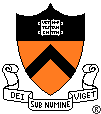

Princeton University
|
Computer Science 597D
|
|
Directory
General Information
Aimed primarily at first and second year graduate students who plan to do research in theoretical computer science. We will introduce probabilistic, algebraic, combinatorial, and algorithmic methods useful in proofs. We will read appropriate research papers that highlight use of such techniques. Students will be expected to do problem sets and to work on open problems. They will be asked to produce scribe notes for a lecture. There might also be "field trips" to theory talks or workshops held in the area, for which students will be expected to write a 1-page report.
Professor: Sanjeev Arora - 307 CS Building - 258-3869 arora@cs.princeton.edu
Graduate Coordinator: Melissa Lawson - 310 CS Building - 258-5387 mml@cs.princeton.edu
Scribe notes: Every student taking or auditing the course is asked to write
scribe notes for a
lecture using the latex system. Relevant style files appear here.
Scribes should strive for good
mathematical style. A few pages from Mathematical
Writing by by Knuth, Larrabee, and Roberts provide some good hints.
Course syllabus:
(Depends to some extent upon the interests of the class; the following are some ideas)
Handouts:
Lecture notes: All lecture notes and assignments in a single file.
Copyright 2002, Sanjeev Arora. All views expressed here are mine and do not reflect
those of the funding agencies.
Work done to develop this course was partly supported by the National Science Foundation
Awards 0205594, CCR 0098180
and the Packard Fellowship. It also benefitted from the opportunity to
visit the Institute for Advanced Study for that academic year.